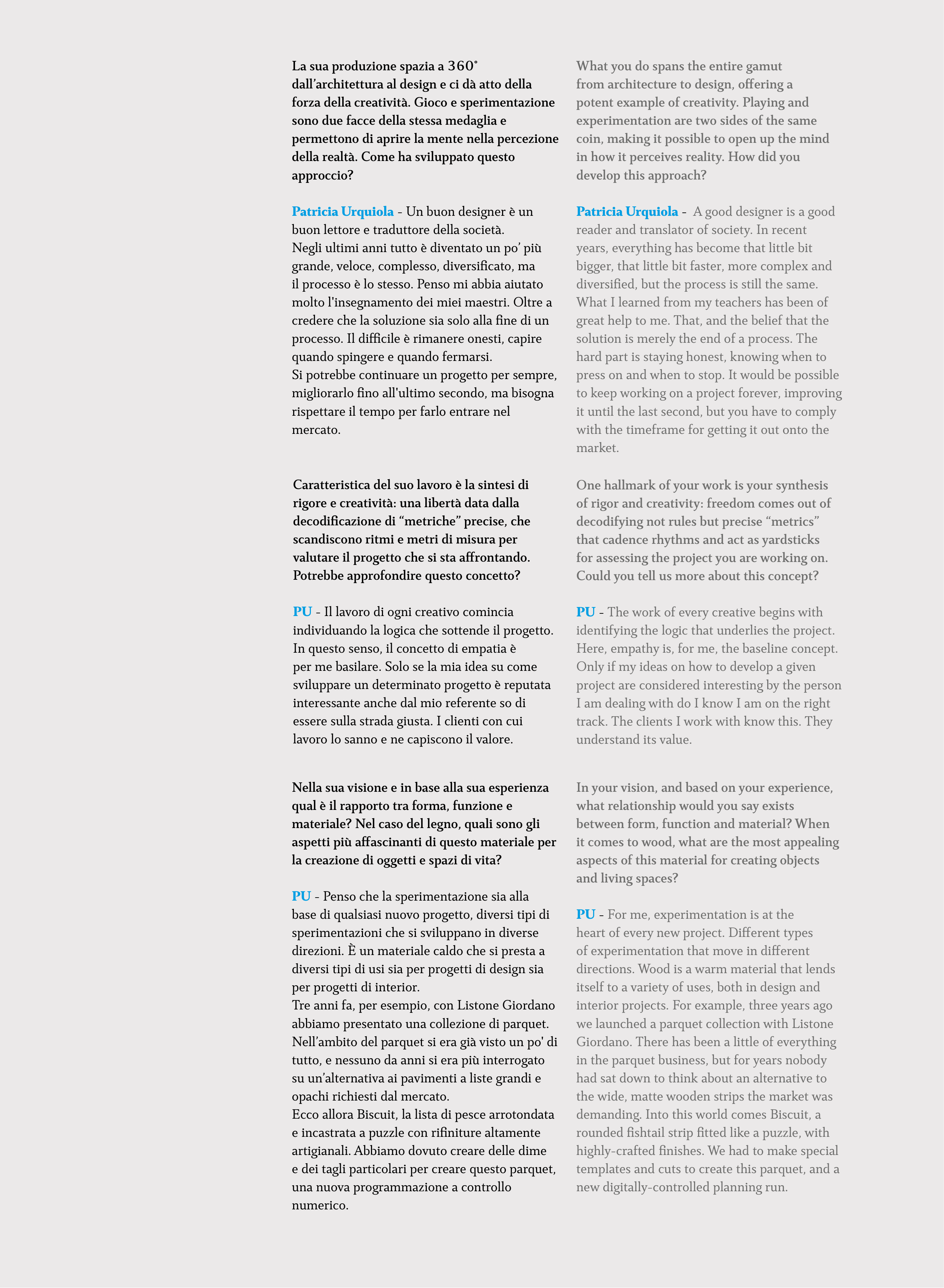La sua produzione spazia a 360°
dall’architettura al design e ci dà atto della
forza della creatività. Gioco e sperimentazione
sono due facce della stessa medaglia e
permettono di aprire la mente nella percezione
della realtà. Come ha sviluppato questo
approccio?
Patricia Urquiola - Un buon designer è un
buon lettore e traduttore della società.
Negli ultimi anni tutto è diventato un po’ più
grande, veloce, complesso, diversificato, ma
il processo è lo stesso. Penso mi abbia aiutato
molto l'insegnamento dei miei maestri. Oltre a
credere che la soluzione sia solo alla fine di un
processo. Il difficile è rimanere onesti, capire
quando spingere e quando fermarsi.
Si potrebbe continuare un progetto per sempre,
migliorarlo fino all'ultimo secondo, ma bisogna
rispettare il tempo per farlo entrare nel
mercato.
Caratteristica del suo lavoro è la sintesi di
rigore e creatività: una libertà data dalla
decodificazione di “metriche” precise, che
scandiscono ritmi e metri di misura per
valutare il progetto che si sta affrontando.
Potrebbe approfondire questo concetto?
PU - Il lavoro di ogni creativo comincia
individuando la logica che sottende il progetto.
In questo senso, il concetto di empatia è
per me basilare. Solo se la mia idea su come
sviluppare un determinato progetto è reputata
interessante anche dal mio referente so di
essere sulla strada giusta. I clienti con cui
lavoro lo sanno e ne capiscono il valore.
One hallmark of your work is your synthesis
of rigor and creativity: freedom comes out of
decodifying not rules but precise “metrics”
that cadence rhythms and act as yardsticks
for assessing the project you are working on.
Could you tell us more about this concept?
PU - The work of every creative begins with
identifying the logic that underlies the project.
Here, empathy is, for me, the baseline concept.
Only if my ideas on how to develop a given
project are considered interesting by the person
I am dealing with do I know I am on the right
track. The clients I work with know this. They
understand its value.
Nella sua visione e in base alla sua esperienza
qual è il rapporto tra forma, funzione e
materiale? Nel caso del legno, quali sono gli
aspetti più affascinanti di questo materiale per
la creazione di oggetti e spazi di vita?
PU - Penso che la sperimentazione sia alla
base di qualsiasi nuovo progetto, diversi tipi di
sperimentazioni che si sviluppano in diverse
direzioni. È un materiale caldo che si presta a
diversi tipi di usi sia per progetti di design sia
per progetti di interior.
Tre anni fa, per esempio, con Listone Giordano
abbiamo presentato una collezione di parquet.
Nell’ambito del parquet si era già visto un po' di
tutto, e nessuno da anni si era più interrogato
su un’alternativa ai pavimenti a liste grandi e
opachi richiesti dal mercato.
Ecco allora Biscuit, la lista di pesce arrotondata
e incastrata a puzzle con rifiniture altamente
artigianali. Abbiamo dovuto creare delle dime
e dei tagli particolari per creare questo parquet,
una nuova programmazione a controllo
numerico.
In your vision, and based on your experience,
what relationship would you say exists
between form, function and material? When
it comes to wood, what are the most appealing
aspects of this material for creating objects
and living spaces?
PU - For me, experimentation is at the
heart of every new project. Different types
of experimentation that move in different
directions. Wood is a warm material that lends
itself to a variety of uses, both in design and
interior projects. For example, three years ago
we launched a parquet collection with Listone
Giordano. There has been a little of everything
in the parquet business, but for years nobody
had sat down to think about an alternative to
the wide, matte wooden strips the market was
demanding. Into this world comes Biscuit, a
rounded fishtail strip fitted like a puzzle, with
highly-crafted finishes. We had to make special
templates and cuts to create this parquet, and a
new digitally-controlled planning run.
What you do spans the entire gamut
from architecture to design, offering a
potent example of creativity. Playing and
experimentation are two sides of the same
coin, making it possible to open up the mind
in how it perceives reality. How did you
develop this approach?
Patricia Urquiola - A good designer is a good
reader and translator of society. In recent
years, everything has become that little bit
bigger, that little bit faster, more complex and
diversified, but the process is still the same.
What I learned from my teachers has been of
great help to me. That, and the belief that the
solution is merely the end of a process. The
hard part is staying honest, knowing when to
press on and when to stop. It would be possible
to keep working on a project forever, improving
it until the last second, but you have to comply
with the timeframe for getting it out onto the
market.


